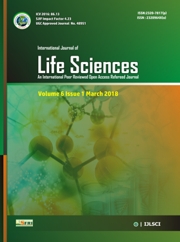RESEARCH ARTICLES
Volume 6 |Issue 6| Nov-Dec 2018 Date of Online:31 December 2018
Heavy metals and their effect on Indian kitchen vegetable
Waghmare SB1 and Anasane PY2
1Department of Chemistry, 2Department of Botany, G.S. Gawande College, Umarkhed 445206 (M.S.) India.
*Corresponding author email: waghmare@gsgcollege.edu.in, | anasane@gsgcollege.edu.in
Abstract
Keywords:Spinach leaves, Tomato, Pd and Cd, health effect.
Editor: Dr.Arvind Chavhan
Cite this article as:
Waghmare SB and Anasane PY. Surface modified nanocrystalline Cr2O3 based thick films for gas sensing. Int. Res. Journal of Science & Engineering, 2018, 6 (6): 236-239.
References
1. Bvenura C, Afolayan AJ. Heavy metal contamination of vegetables cultivated in home gardens in the Eastern Cape. South African Journal of Science. 2012;108: 9-10,doi: 10.4102/sajs.v108i9/10.696.
2. Khairiah et al. Heavy metal concentrations in vegetables grown in the vicinity of closed dumpsite, IJES, 2004; 2(2): 2011.
3. Mohajer et al. Metals accumulation in vegetables may pose a direct threat to human health, 2012.
4. Razaal. Market basket survey for some heavy metals in Egyptian fruits and vegetables,” Food and Chemical Toxicology, 2005; 44 (8): 1273–1278.
5. Awashthi SK. Prevention of Food Adulteration Act no. 37 of 1954. Central and State Rules as Amended for 1999, Ashoka Law House, New Delhi. 2000.
6. European Union. Heavy Metals in Wastes, European Commission on Environment. 2000
7. WHO (2000) Safety evaluation of certain food additives and contaminants. International Programme on Chemical Safety. WHO Food Additive Series 52. 25.
8. WHO (2004) Task group on environmental health criteria for arsenic and Arsenic Compounds 18, World Health Organization, Geneva, Switzerland 1-174.
9. CODEX. Working document for information and use in discussions related to contaminants and toxins in the GSCTFF. Codex Alimentarius Commission; Rome, Italy: 2011. pp. 13–15.
10. Khan S, Zheng YM, Huang YZ, Zhru YG. Health risks of heavy metals in contaminated soils and food crops irrigated with waste water in Beijing Environmental pollution, 2008.
11. Akan JC, BG, Kolo BS, Yikala VO, Ogugbuaja. Determination of Some Heavy Metals in Vegetable Samples from Biu Local Government Area, Borno State, North Eastern Nigeria” International Journal of Environmental Monitoring and Analysis, 2013; 1(2): 40-46.

